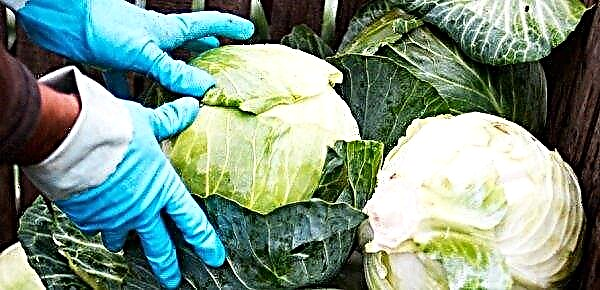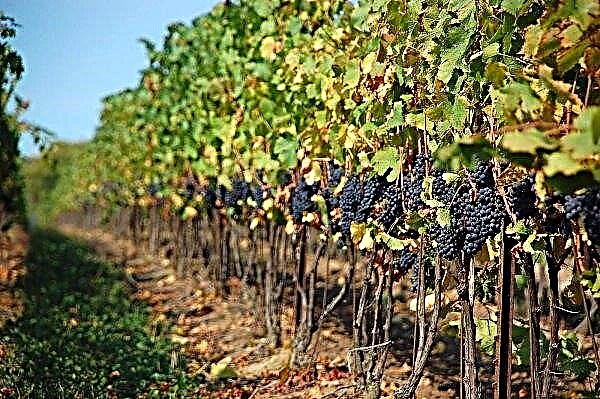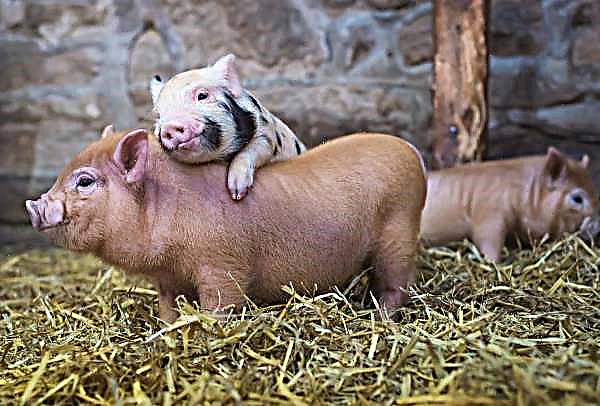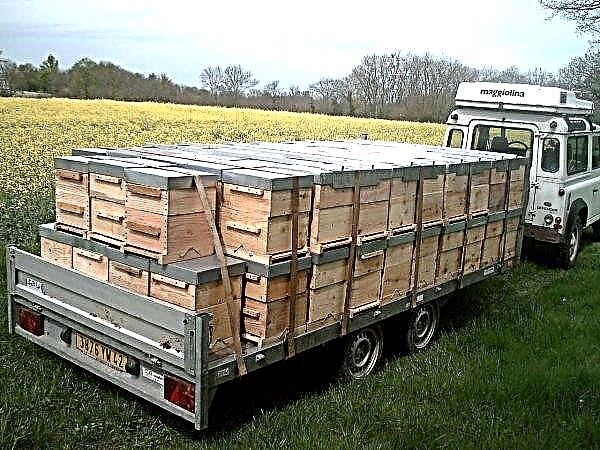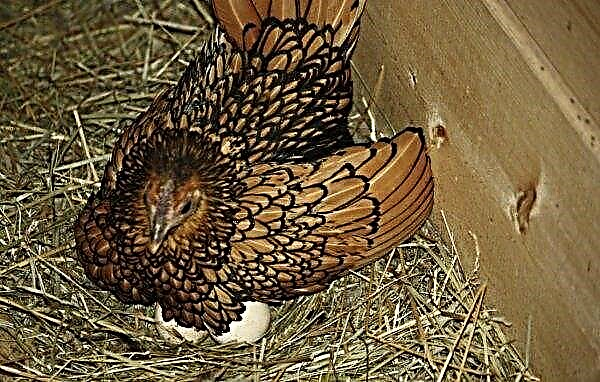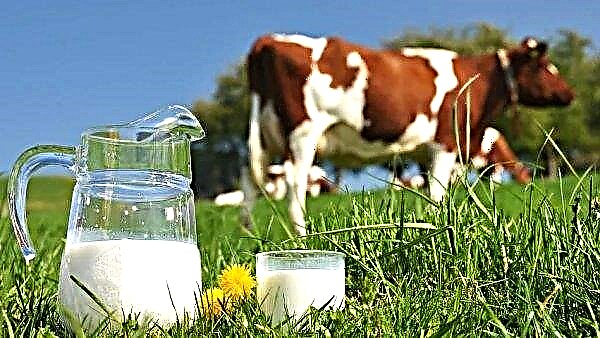Large sweet and sour, slightly tart blueberry berries of a dark blue color have won the recognition of many people, which is not surprising - they are very tasty, low-calorie and rich in minerals. This perennial bush is not difficult to grow in the garden even for a novice gardener. The article is devoted to the early tall blueberry variety Erlible: it contains the characteristics and description of the bush, gives recommendations for planting and growing crops.
Description of Blueberry Erlible
All wild-growing representatives of the culture are characterized by a short bush, with shoots up to 35–40 cm. Erliblu height reaches 1.2–1.8 m. It is characterized by a slightly spreading form and vertical branches. In May, flower buds form on last year’s and older processes, and the crop matures in late July.
The plant has small green oval leaves, during flowering reveals not large star-shaped flowers of a white-pink hue. The berries have a spherical or slightly flattened shape, a diameter of 14 to 18 mm and a mass of 1.8–2.2 g. Very large fruits are formed at the beginning of the season, but with each subsequent ripening wave they become smaller.Their surface is painted blue with a white waxy coating, due to the high content of anthocyanins in the pulp cells under the skin of the fetus. Frost resistance is very high., without damaging the aboveground and underground parts, the plant can withstand low temperatures up to –37 ° C. The culture is very demanding on soil moisture in the root zone.Did you know? Sometimes not too experienced gardeners confuse blueberries and blueberries. In order to distinguish them from each other, you need to examine the aerial part of the bush: the first plant has flexible light green shoots, and the second grows berries on brown lignified branches.
Chemical composition
Ripe blueberries are delicious, they can be consumed fresh or made from them jams, preserves and juices. They are ideal for freezing and retain most of their properties as such.
In 100 g of fresh berries:
- water - 83.4 g;
- proteins - 0.6 g;
- fats - 0.6 g;
- carbohydrates - 15 g;
- B1 - 0.02 mg;
- B2 - 0.02 mg;
- PP - 0.3 mg;
- C - 16 mg;
- calcium - 16 mg;
- phosphorus - 13 mg;
- iron - 0.8 mg;
- energy value - 61 calories.

Useful properties and contraindications
Blueberry fruits are not only a wealth of micro and macro elements, as evidenced by research, but also unique properties due, inter alia, to the high content of antioxidants that neutralize free radicals, thereby limiting the formation and development of cancer.
Important! Infusions on blueberry leaves have a therapeutic effect on human digestion and eliminate cough.
- Substances contained in berries:
- reduce bad cholesterol (LDL);
- beneficial effect on vision, memory;
- slow down the aging process;
- contribute to the good work of the heart and the entire circulatory system;
- prevent bladder infections;
- possess antibacterial activity and properties of natural antioxidants;
- produce anti-cancer cells;
- have antidiarrheal properties;
- rich in phytoestrogens, mitigating the period of hormonal changes in women and men.

Blueberries should not be consumed by people with heart and vascular disease, since the substances contained in it accelerate coagulation and thicken blood. Also, it is undesirable to eat berries uncontrollably for women bearing a fetus, or for mothers during lactation - they definitely need a consultation from a doctor or pediatrician observing the pregnancy.
Important! Recently, a new variety of blueberries called Pink Lemonade has appeared. The ripe fruits of this plant are painted in coral color.
Landing rules
Culture loves sunny, secluded and warm places. Shrubs should not be planted in the shade, as this negatively affects the laying of flower buds and the quality of ripening berries, as well as the absence of sun and waterlogging contribute to the development of fungal diseases. Blueberries are best developed and bear fruit on light and sandy, acidic soils with a high humus content.
For her, the correct soil reaction is one of the most important conditions for the formation of a good crop: the optimum pH of the substrate should remain between 3.8–4.8. A plant develops well in the earth, warming up during the growing season to +18 ... + 21 ° C.
Since the shrub is best fruiting on strongly acidic soils, it is usually necessary to prepare a special plot for it in the garden. The substrate should be enriched with organic matter, for this you can use acidic ground peat, which is mixed with native soil in a ratio of 1: 1 to a depth of about 40 cm.The surface of the beds under the seedlings is mulched with old sawdust, pine bark or last year's leaves.
Did you know? Blueberries give a person a steady blue color. In order to get rid of unnatural coloring, it is enough to wipe the skin with a cloth dampened in table vinegar.
Acidification of the area under blueberries can be done in another way. To do this, dig a hole, and then cover its walls with a black (perforated or manually punctured) film. Also, a ground container (an old barrel, a large pot) with an opening for drainage of moisture in the bottom can be placed in the ground. Then, a layer of acid peat mixed with chopped pine bark (spruce needles, oak leaves, sawdust of coniferous trees) and sand is poured into a recess or container, in a ratio of 2: 1: 1.
Recommendations for determining blueberries in a permanent place:
- Shrub transplantation can be performed in spring or autumn. Planting at the beginning of the growing season is less risky because young plants are not exposed to frost. The best autumn month for such work is September.
- Seedlings are best bought in pots. Before starting transshipment, the container with the plant is placed in water and left in this position until the entire root system is saturated with moisture.
- These berry bushes can be planted separately or in groups. If the gardener wants to plant them in rows, then they should be at least 2 m apart from each other. It is recommended to observe the interval between plants from 80 to 150 cm.
- If you need to transplant an already growing blueberry, then first you should also prepare a suitable substrate with the addition of acid peat. The plant is removed from the earth together with the soil lump with the help of a pitchfork, transferred and placed in a well prepared in a new place. Dug in this way, it retains most of the roots. Landing is carried out to the previous depth. The best time for transplanting an adult shrub is the second half of September.
- Since the harvest of blueberries depends on pollination, the correct choice of planting neighboring plants is a very important factor when growing this crop on a personal plot. Airlibl should be planted next to several varieties with different ripening times, which will contribute not only to good yield, but also to the owner of the garden to get berries for a longer period. Varieties such as Early Blue, Patriot, Bluecrop, Bluejay, Berkeley, Jersey, Bluegold, Herbert, Bridgette Blue and Darrow are suitable for these purposes.

Subtleties of care and maturity
Shrub growth stops even when the outdoor thermometer drops to + 3 ° C. Higher temperatures contribute to the rapid development of the culture and early ripening of berries. Spring colds delay the flowering of blueberries, weaken the growth of roots and inhibit the absorption of nutrients, as often indicated by reddened young leaves. This symptom disappears when it becomes warm.
Did you know? At a time when Great Britain entered the war against Nazi Germany, the daily diet of combat aircraft pilots was includedabout blueberry jam. English physicians claimed that this product significantly improves human vision.
Shrub Care:
- Spanbond insulation - it is recommended to carry out in case of late spring frosts that can damage swollen or already blossoming flower buds.

- Mulching - The best solution would be to use organics, creating the most favorable conditions for the growth and fruiting of the culture. Thanks to this, the earth retains moisture longer, and a gradually decomposing layer of mulch provides bushes with easily digestible minerals. In the summer, the natural coating of the soil maintains the temperature of the root zone at the same level and does not allow it to dry out, and in winter it prevents freezing. This agricultural technique allows maintaining the pH of the substrate at an appropriate level. The best material for covering the surface under blueberries is sawdust of conifers, pine bark, oak leaves and acid peat.

- Weeding and loosening the soil - if the ground around the bushes is covered with litter, this will significantly reduce the growth of weeds, and therefore, there will be no need for these works. If the soil is in the open state, it is important to regularly treat it with a chopper or a hand cultivator. This must be done very carefully so as not to damage the root system of the blueberry.

Rules for pruning blueberries to Erlible:
- Pruning of young bushes is carried out in early spring, even if transplantation work was carried out the previous fall. If the seedlings were two years old at the time of planting and they had a well-developed root system, it is worthwhile to slightly shorten the main shoots, which should be 4-5. Small processes on the root neck are also removed. If the plant's underground part was weak, then the powerful branches should be cut off by half, and all weak ones should be removed. At the same time, it is advisable to pinch off flower buds that weaken the vegetative growth of a young bush.
- In subsequent years, sanitary care and rejuvenation of the shrub is carried out with the help of annual pruning, which is performed in February or March. The main objective of the procedure is to monitor crown compaction. Gardeners use pruning shears to remove weak, dead and barren branches. This allows you to control growth, the crown becomes more rarefied, due to which more sunlight and air penetrate inside, thereby reducing the risk of diseases and improving the quality of berries.
- Thanks to pruning, the gardener can form strong annual processes on which flower buds will form next year. An adult plant should have from 6 to 8 main offspring, of which 2 or 3 are branches that are 3-4 years old, and the rest are biennial or annual.
- It is important to cut blueberries on time. The procedure, carried out too early (in January), can contribute to frost damage to the aerial part of the shrub. With late conduct, the substances accumulated in the roots already begin to move to the aerial part, and cutting off the processes can lead to their loss, which will additionally delay the growth of young branches and weaken the bush.
- If you need to rejuvenate with pruning an old, almost fruitless bush, it is best to do this in early spring, in early March, so that new shoots can grow correctly, and the damage to the wood has time to last until winter. All the main branches are shortened to a height of 10-30 cm. In the first year, a strong new growth is formed, forming a rejuvenated crown of the plant. Fruit buds on a shrubbery will bloom next year.

Watering and feeding
Due to the shallow roots, the culture needs a lot of moisture. In the spring, the soil usually has significant water reserves, but drought may occur from May to June, which is undesirable because it causes a halt in the development of plants and dehydration of the fruit set. For this reason, the soil must be maintained in a slightly wet state, especially during the growth and development of blueberries, as well as during the ripening period.
If, when monitoring the state of the substrate, the position of the arrow of the hygrometer drops below 50%, it is necessary to irrigate the berry once a week. It should also be remembered that the bush does not tolerate waterlogging: if the roots remain flooded for more than a day, damage will appear on the bushes and the roots will gradually die due to a lack of oxygen. Tall blueberries are plants with very little nutritional needs. But it should be borne in mind that its roots are very small and cannot use substances accumulated in deeper layers of the soil, which is important when fertilizing a plant.
Tall blueberries are plants with very little nutritional needs. But it should be borne in mind that its roots are very small and cannot use substances accumulated in deeper layers of the soil, which is important when fertilizing a plant.Important! Chemical mixtures containing chlorides in the composition cannot be added under the blueberry bushes, since the plants are highly sensitive to this substance.
Types of fertilizers:
- Organics - you can take natural dressings in the form of dried or granular manure, as well as compost or vermicompost. They are recommended to be mixed with bark of coniferous trees or acid peat and laid out on the surface of the soil under the bushes. To fertilize young seedlings, you can apply root fertilizer with liquid "green manure" obtained as a result of fermentation of nettles, dandelions, wormwood.
- Mineral Feeding - they should be based on soil analysis. Such testing can be ordered at the agrochemical laboratory, and then, depending on the needs, make suitable substances. In garden centers you can buy fertilizers specifically designed for culture, lovers should use them.

Winter preparations
Thanks to its excellent winter hardiness, Erlible absolutely does not need additional shelter from the cold both aboveground and underground parts of the plant. But in autumn, organic fertilizers can be decomposed under the bush, which will gradually decompose during the winter period, enriching the soil layer and at the same time serving as an additional “blanket” for the roots.
Collection and storage of blueberries
The first ripe Erliblu berries begin to appear in June: they are very fragrant, have an optimal sugar content and a beautiful blue color. Fruits can remain on branches for several days (4–5), without losing taste and not falling to the ground. This blueberry sings unevenly, depending on the weather, so ripening can last from 3 to 5 weeks, which requires several stages of harvesting during the season.
It is harvested at the stage of full maturity, when the petiole is easily separated from the place of attachment. The fruits can be stored in the refrigerator or in a cool room for 10-12 days. For the winter it is better to freeze or make jam.
Pests and diseases
Blueberries grown in small gardens are rarely affected by disease. They are much more common when growing crops on industrial sites. Nevertheless, it is worthwhile to study the symptoms of diseases that are often found in the culture. The shrub can be attacked by several fungi and viruses, usually this is facilitated by cool and humid (spring or autumn) weather. Pests can also attack the plant.
The most common blueberry diseases include:
- Necrosis - gangrene affects young processes at the age of 1-2 years. Symptoms of the disease: small spots form in the lower part of the branches, surrounded by a red-purple rim. Over time, they grow, become gray, and black spherical bodies of the mycelium appear on their surface. Over time, the disease covers the entire shoot, which leads to its death.

- Gray mold - causes necrosis of green shoots, flowers, leaves and berries.Blueberry branches and flowers turn brown and dry, and the fruits rot. Bluish large spots appear on the leaves, and at high humidity a characteristic whitish dusty mycelium appears.

- Anthracnose - the disease manifests itself primarily on ripening berries in the form of small dark spots, later the fruits begin to rot. Shoots and leaves, on which areas of infection of various shapes develop, can also be affected.

- White spotting - the disease is visible on the leaves in the form of small spots, painted in the center in white and gray, and surrounded by a reddish-brown rim. Small dark growths form on the infected surface. A high degree of damage causes premature fall of shrub leaves.

Currently, there are few plant protection products registered for controlling diseases in the cultivation of this crop, therefore prevention is very important.
Preventive measures:
- shoots, leaves or fruits on which the symptoms of the disease appeared, should be removed from the garden and burned;
- the branches are cut so as to completely cut off the diseased tissue;
- you can use the drug Switch 62.5 WGot, but only in the fight against gray mold and blueberry anthracnosis.
The gardener is advised to regularly check the shrub for the presence of harmful insects. As soon as they are detected in an amount of more than 20 individuals, it is necessary to spray the plant with one of the insecticides, for example, with the preparations "Karate", "Actara". If the blueberry infection is high, then it is advisable to do the re-treatment no later than 10 days after the first: this time is enough for the appearance of young animals (from the clutch left by pests). Work with chemicals should be carried out only in dry weather, it is advisable that at the end of the procedure, rain is not expected for two to three hours. A person involved in cleaning plants from parasites must be protected from the effects of harmful elements. To do this, close the body with dense clothing with long sleeves, the head with a hood, the respiratory organs with a respirator, and the eyes with glasses.
Work with chemicals should be carried out only in dry weather, it is advisable that at the end of the procedure, rain is not expected for two to three hours. A person involved in cleaning plants from parasites must be protected from the effects of harmful elements. To do this, close the body with dense clothing with long sleeves, the head with a hood, the respiratory organs with a respirator, and the eyes with glasses.
Despite the fact that planting a shrub Erliblyu and care for it require some effort from the summer resident, it is worth growing blueberries because of its excellent taste and beneficial properties. The plant can also be a decorative element of the garden, as it blooms beautifully in the spring, its leaves remain green during the summer, and with the onset of autumn change color to orange or red.








